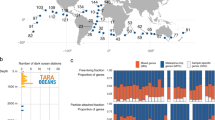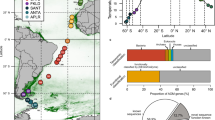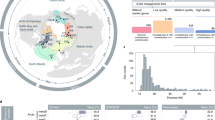Abstract
The history of microbial evolution in the oceans is probably as old as the history of life itself. In contrast to terrestrial ecosystems, microorganisms are the main form of biomass in the oceans, and form some of the largest populations on the planet. Theory predicts that selection should act more efficiently in large populations. But whether microbial plankton populations harbour organisms that are models of adaptive sophistication remains to be seen. Genome sequence data are piling up, but most of the key microbial plankton clades have no cultivated representatives, and information about their ecological activities is sparse.
This is a preview of subscription content, access via your institution
Access options
Subscribe to this journal
Receive 51 print issues and online access
$199.00 per year
only $3.90 per issue
Buy this article
- Purchase on Springer Link
- Instant access to full article PDF
Prices may be subject to local taxes which are calculated during checkout


Similar content being viewed by others
References
Michaels, A. F. et al. Seasonal patterns of ocean biochemistry at the U. S. JGOFS Bermuda Atlantic Time Series study site. Deep-Sea Res. 41, 1013–1038 (1994).
Ducklow, H. in Microbial ecology of the oceans (ed. Kirchman, D. L.) 85–120 (Wiley-Liss, New York, 2000).
Fuhrman, J. A. & Noble, R. T. Viruses and protists cause similar bacterial mortality in coastal seawater. Limnol. Oceanogr. 40, 1236–1242 (1995).
Carlson, C. A., Ducklow, H. W. & Michaels, A. F. Annual flux of dissolved organic carbon from the euphotic zone in the northwestern Sargasso Sea. Nature 371, 405–408 (1994).
Bauer, J. E., Williams, P. M. & Druffel, E. R. M. 14C activity of dissolved organic carbon fractions in the north-central Pacific and Sargasso Sea. Nature 357, 667–670 (1992).
Benner, R. in Biogeochemistry of Marine Dissolved Organic Matter (eds Hansell, D. A. & Carlson, C. A.) 59–85 (Academic, 2002).
Hansell, D. A. & Carlson, C. A. Biogeochemistry of total organic carbon and nitrogen in the Sargasso Sea: control by convective overturn. Deep-Sea Res. Part Ii-Topical Studies in Oceanogr. 48, 1649–1667 (2001).
Baumann, P. & Schubert, R. H. W. in Bergey's Manual of Systematic Bacteriology (eds Krieg, N. R. & Holt, J. G.) 518–544 (Williams & Wilkins, Baltimore, 1984).
Giovannoni, S. J. & Rappé, M. S. in Microbial Ecology of the Oceans (ed. Kirchman, D. L.) 47–85 (Wiley-Liss, New York, 2000).
Britschgi, T. B. & Giovannoni, S. J. Phylogenetic analysis of a natural marine bacterioplankton population by rRNA gene cloning and sequencing. Appl. Environ. Microbiol. 57, 1313–1318 (1991).
Fuhrman, J. A., McCallum, K. & Davis, A. A. Novel major archaebacterial group from marine plankton. Nature 356, 148–149 (1992).
Fuhrman, J. A., McCallum, K. & Davis, A. A. Phylogenetic diversity of subsurface marine microbial communities from the Atlantic and Pacific oceans. Appl. Environ. Microbiol. 59, 1294–1302 (1993).
Giovannoni, S. J., Britschgi, T. B., Moyer, C. L. & Field, K. G. Genetic diversity in Sargasso Sea bacterioplankton. Nature 345, 60–63 (1990).
Schmidt, T. M., DeLong, E. F. & Pace, N. R. Analysis of a marine picoplankton community by 16S rRNA gene cloning and sequencing. J. Bacteriol. 173, 4371–4378 (1991).
Mullins, T. D., Britschgi, T. B., Krest, R. L. & Giovannoni, S. J. Genetic comparisons reveal the same unknown bacterial lineages in Atlantic and Pacific bacterioplankton communities. Limnol. Oceanogr. 40, 148–158 (1995).
DeLong, E. F. & Karl, D. M. Perspectives in microbial oceanography. Nature 437, 336–342.
Acinas, S. G. et al. Fine-scale phylogenetic architecture of a complex bacterial community. Nature 430, 551–554 (2004).
Venter, J. C. et al. Environmental genome shotgun sequencing of the Sargasso Sea. Science 304, 66–74 (2004).
Eder, W., Schmidt, M., Koch, M., Garbe-Schonberg, D. & Huber, R. Prokaryotic phylogenetic diversity and corresponding geochemical data of the brine-seawater interface of the Shaban Deep, Red Sea. Environ. Microbiol. 4, 758–763 (2002).
Fuhrman, J. A., McCallum, K. & Davis, A. A. Widespread archaea and novel bacteria from the deep sea as shown by 16S rRNA gene sequences. Mar. Ecol. Prog. Ser. 150, 275–285 (1997).
Giovannoni, S., Rappé, M., Vergin, K. & Adair, N. 16S rRNA genes reveal stratified open ocean bacterioplankton populations related to the Green Non-Sulfur bacteria. Proc. Natl Acad. Sci. USA 93, 7979–7984 (1996).
Gordon, D. A. & Giovannoni, S. J. Stratified microbial populations related to Chlorobium and Fibrobacter detected in the Atlantic and Pacific Oceans. Appl. Environ. Microbiol. 62, 1171–1177 (1996).
Wright, T. D., Vergin, K. L., Boyd, P. W. & Giovannoni, S. J. A novel delta-subdivision proteobacterial lineage from the lower ocean surface layer. Appl. Environ. Microbiol. 63, 1441–1448 (1997).
Karner, M. B., DeLong, E. F. & Karl, D. M. Archaeal dominance in the mesopelagic zone of the Pacific Ocean. Nature 409, 507–510 (2001).
Morris, R. M. et al. SAR11 clade dominates ocean surface bacterioplankton communities. Nature 420, 806–810 (2002).
Field, K. G. et al. Diversity and depth-specific distribution of SAR11 cluster rRNA genes from marine planktonic bacteria. Appl. Environ. Microbiol. 61, 63–70 (1997).
Morris, R. M., Cho, J. C., Rappé, M. S., Vergin, K. L. & Carlson, C. A. Bacterioplankton responses to deep seasonal mixing in the Sargasso Sea. Limnol. Oceanogr. 50, 382–391 (2005).
Rappé, M. S., Vergin, K. & Giovannoni, S. J. Phylogenetic comparisons of a coastal bacterioplankton community with its counterparts in open ocean and freshwater systems. FEMS Microbiol. Ecol. 33, 219–232 (2000).
Wuchter, C., Schouten, S., Boschker, H. T. & Sinninghe Damste, J. S. Bicarbonate uptake by marine Crenarchaeota. FEMS Microbiol. Lett. 219, 203–207 (2003).
DeLong, E. F. Archaea in coastal marine bacterioplankton. Proc. Natl Acad. Sci. USA 89, 5685–5689 (1992).
Zubkov, M. V. et al. Linking the composition of bacterioplankton to rapid turnover of dissolved dimethylsulphoniopropionate in an algal bloom in the North Sea. Environ. Microbiol. 3, 304–311 (2001).
Zubkov, M. V., Fuchs, B. M., Tarran, G. A., Burkill, P. H. & Amann, R. High rate of uptake of organic nitrogen compounds by Prochlorococcus cyanobacteria as a key to their dominance in oligotrophic oceanic waters. Appl. Environ. Microbiol. 69, 1299–1304 (2003).
Malmstrom, R. R., Kiene, R. P., Cottrell, M. T. & Kirchman, D. L. Contribution of SAR11 bacteria to dissolved dimethylsulfoniopropionate and amino acid uptake in the North Atlantic ocean. Appl. Environ. Microbiol. 70, 4129–4135 (2004).
Cohan, F. M. What are bacterial species? Annu. Rev. Microbiol. 56, 457–487 (2002).
Thompson, J. R. et al. Diversity and dynamics of a north Atlantic coastal Vibrio community. Appl. Environ. Microbiol. 70, 4103–4110 (2004).
Kimura, M. On the probability of fixation of mutant genes in populations. Genetics 47, 713–719 (1962).
Moore, L. R., Rocap, G. & Chisholm, S. W. Physiology and molecular phylogeny of coexisting Prochlorococcus ecotypes. Nature 393, 464–467 (1998).
Rocap, G., Distel, D. L., Waterbury, J. B. & Chisholm, S. W. Resolution of Prochlorococcus and Synechococcus ecotypes by using 16S-23S ribosomal DNA internal transcribed spacer sequences. Appl. Environ. Microbiol. 68, 1180–1191 (2002).
Rocap, G. et al. Genome divergence in two Prochlorococcus ecotypes reflects oceanic niche differentiation. Nature 424, 1042–1047 (2003).
Béjà, O. et al. Bacterial rhodopsin: evidence for a new type of phototrophy in the sea. Science 289, 1902–1906 (2000).
Kölber, Z. S., Van Dover, C. L., Niederman, R. A. & Falkowski, P. G. Bacterial photosynthesis in surface waters of the open ocean. Nature 407, 177–179 (2000).
Béjà, O., Spudich, E. N., Spudich, J. L., Leclerc, M. & DeLong, E. F. Proteorhodopsin phototrophy in the ocean. Nature 411, 786–789. (2001).
Schwalbach, M. S., Brown, M. & Fuhrman, J. A. Impact of light on marine bacterioplankton community structure. Aquat. Microb. Ecol. 39, 235–245 (2005).
Man, D. et al. Diversification and spectral tuning in marine proteorhodopsins. EMBO J. 22, 1725–1731 (2003).
Stevenson, B. S. & Schmidt, T. M. Life history implications of rRNA gene copy number in Escherichia coli. Appl. Environ. Microbiol. 70, 6670–6677 (2004).
Azam, F. & Long, R. A. Sea snow microcosms. Nature 414, 495–498 (2001).
Carlson, C. A. et al. Effect of nutrient amendments on bacterioplankton production, community structure, and DOC utilization in the northwestern Sargasso Sea. Aquat. Microb. Ecol. 30, 19–36 (2002).
Fuchs, B. M., Zubkov, M. V., Sahm, K., Burkill, P. H. & Amann, R. Changes in community composition during dilution cultures of marine bacterioplankton as assessed by flow cytometric and molecular biological techniques. Environ. Microbiol. 2, 191–201 (2000).
Rappé, M. S., Connon, S. A., Vergin, K. L. & Giovannoni, S. J. Cultivation of the ubiquitous SAR11 marine bacterioplankton clade. Nature 418, 630–633 (2002).
Dethlefsen, L. & Schmidt, T. M. Differences in codon bias cannot explain differences in translational power among microbes. BMC Bioinformatics 6, 3 (2005).
Button, D. K., Robertson, B., Gustafson, E. & Zhao, X. Experimental and theoretical bases of specific affinity, a cytoarchitecture-based formulation of nutrient collection proposed to supercede the Michaelis–Menten paradigm of microbial kinetics. Appl. Environ. Microbiol. 70, 5511–5521 (2004).
Kohfeld, K. E., Le Quere, C., Harrison, S. P. & Anderson, R. F. Role of marine biology in glacial-interglacial CO2 cycles. Science 308, 74–78 (2005).
DeLong, E. F., Franks, D. G. & Alldredge, A. L. Phylogenetic diversity of aggregate-attached vs. free-living marine bacterial assemblages. Limnol. Oceanogr. 38, 924–934 (1993).
Kirchman, D. L. The ecology of Cytophaga-Flavobacteria in aquatic environments. FEMS Microbiol. Ecol. 39, 91–100 (2002).
Cho, J. C., Vergin, K. L., Morris, R. M. & Giovannoni, S. J. Lentisphaera araneosa gen. nov., sp. nov., a transparent exopolymer producing marine bacterium, and the description of a novel bacterial phylum, Lentisphaerae. Environ. Microbiol. 6, 611–621 (2004).
Suttle, C. Viruses in the sea. Nature 437, 356–361 (2005).
Mayali, X. & Azam, F. Algicidal bacteria in the sea and their impact on algal blooms. J. Eukaryot. Microbiol. 51, 139–144 (2004).
Egan, S., Thomas, T., Holmstrom, C. & Kjelleberg, S. Phylogenetic relationship and antifouling activity of bacterial epiphytes from the marine alga Ulva lactuca. Environ. Microbiol. 2, 343–347 (2000).
Lovejoy, C., Bowman, J. P. & Hallngraeff, G. M. Algicidal effects of a novel marine Pseudoalteromonas isolate (Class Proteobacteria, Gamma subdivision) on harmful algal bloom species of the genera Chattonella, Gymnodinium and Heterosigma. Appl. Environ. Microbiol. 64, 2806–2813 (1998).
Jenkins, B. D., Steward, G. F., Short, S. M., Ward, B. B. & Zehr, J. P. Fingerprinting diazotroph communities in the Chesapeake Bay by using a DNA macroarray. Appl. Environ. Microbiol. 70, 1767–1776 (2004).
Zehr, J. P., Jenkins, B. D., Short, S. M. & Steward, G. F. Nitrogenase gene diversity and microbial community structure: a cross-system comparison. Environ. Microbiol. 5, 539–554 (2003).
Montoya, J. P. et al. High rates of N2 fixation by unicellular diazotrophs in the oligotrophic Pacific Ocean. Nature 430, 1027–1032 (2004).
Moran, M. A. et al. Genome sequence of Silicibacter pomeroyi reveals adaptations to the marine environment. Nature 432, 910–913 (2004).
Orcutt, K. M. et al. Characterization of Trichodesmium spp. by genetic techniques. Appl. Environ. Microbiol. 68, 2236–2245 (2002).
Button, D. K., Schut, F., Quang, P., Martin, R. & Robertson, B. R. Viability and isolation of marine bacteria by dilution culture: theory, procedures, and initial results. Appl. Environ. Microbiol. 59, 881–891 (1993).
Vancanneyt, M. et al. Sphingomonas alaskensis sp. nov., a dominant bacterium from a marine oligotrophic environment. Int. J. Syst. Evol. Microbiol. 51, 73–79 (2001).
Cavicchioli, R., Ostrowski, M., Fegatella, F., Goodchild, A. & Guixa-Boixereu, N. Life under nutrient limitation in oligotrophic marine environments: an eco/physiological perspective of Sphingopyxis alaskensis (formerly Sphingomonas alaskensis). Microb. Ecol. 45, 203–217 (2003).
Cho, J. C. & Giovannoni, S. J. Cultivation and growth characteristics of a diverse group of oligotrophic marine γ-Proteobacteria. Appl. Environ. Microbiol. 70, 432–40 (2004).
Connon, S. A. & Giovannoni, S. J. High-throughput methods for culturing microorganisms in very-low-nutrient media yield diverse new marine isolates. Appl. Environ. Microbiol. 68, 3878–3885 (2002).
Simu, K. & Hagstrom, A. Oligotrophic bacterioplankton with a novel single-cell life strategy. Appl. Environ. Microbiol. 70, 2445–2451 (2004).
Azam, F. et al. The ecological role of water-column microbes in the sea. Mar. Ecol. Prog. Ser. 10, 257–263 (1983).
DeLong, E. F. Microbial community genomics in the ocean. Nature Rev. Microbiol. 3, 459–469 (2005).
Acknowledgements
This work was supported by a research grant from the NSF Microbial Observatories Program and a grant from the Gordon and Betty Moore Foundation.
Author information
Authors and Affiliations
Corresponding author
Ethics declarations
Competing interests
The authors declare no competing financial interests.
Additional information
Author Information Reprints and permissions information is available at npg.nature.com/reprintsandpermissions.
Rights and permissions
About this article
Cite this article
Giovannoni, S., Stingl, U. Molecular diversity and ecology of microbial plankton. Nature 437, 343–348 (2005). https://doi.org/10.1038/nature04158
Published:
Issue Date:
DOI: https://doi.org/10.1038/nature04158
This article is cited by
-
Atmospheric deposition and river runoff stimulate the utilization of dissolved organic phosphorus in coastal seas
Nature Communications (2024)
-
Five Years Measuring the Muck: Evaluating Interannual Variability of Nutrient Loads From Tidal Flooding
Estuaries and Coasts (2023)
-
Vertical microbial profiling of water column reveals prokaryotic communities and distribution features of Antarctic Peninsula
Acta Oceanologica Sinica (2023)
-
Emergent community architecture despite distinct diversity in the global whale shark (Rhincodon typus) epidermal microbiome
Scientific Reports (2023)
-
Dynamics of actively dividing prokaryotes in the western Mediterranean Sea
Scientific Reports (2022)
Comments
By submitting a comment you agree to abide by our Terms and Community Guidelines. If you find something abusive or that does not comply with our terms or guidelines please flag it as inappropriate.



